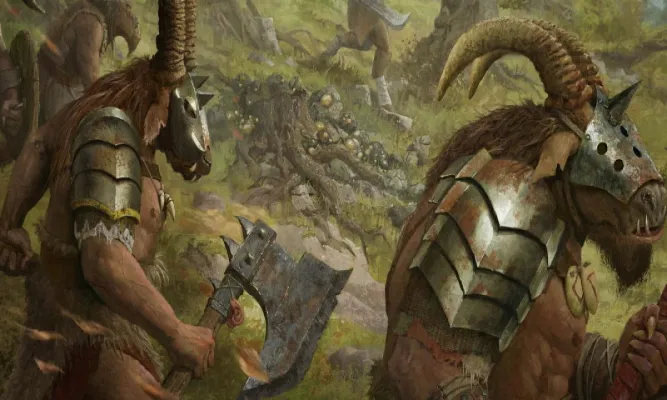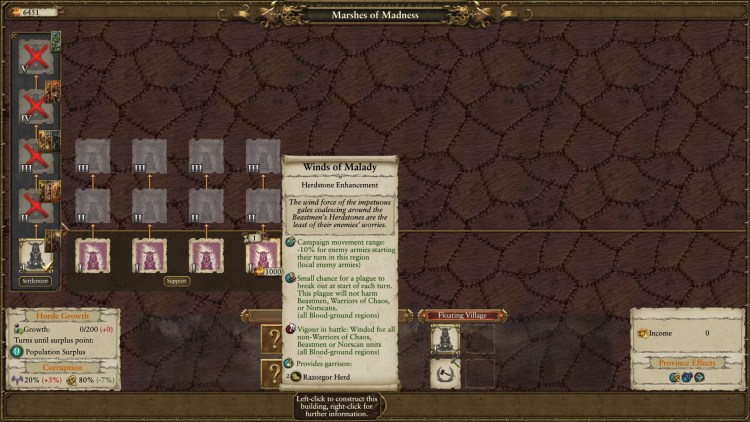Total War: Warhammer II – Beastmen rework key progression mechanics
This time, we’ll talk about the key mechanics for campaign progression such as Herdstones, Bloodgrounds, and more.
Herdstones and buildings
When you begin your Total War: Warhammer II campaign as the Beastmen, you’ll automatically have one Herdstone resource. Then, once you capture a settlement, one of the options that’ll be presented is “Raise Herdstone.” If you choose this, the area becomes a mini-settlement of sorts.
A Herdstone creates a Bloodground (more on this later), but it also allows you to construct a few buildings. The main Herdstone building chain helps with local army movement, ambushing, and horde recruitment capacity. Likewise, you’ll receive better garrison troops to defend the Herdstone itself. There are also four support building chains that give extra boons and garrisoned units:
- Carrion Offerings – Casualty replenishment, Chaos corruption, and horde recruitment capacity.
- Shamanic Challenges – Winds of Magic reserves, line-of-sight, and Dread gains.
- Rucking Pits – Siege tower construction, extra ammunition, enemy reload time increase, and reduced enemy missile damage.
- Winds of Malady – Reduced local enemy campaign movement, causes enemies to become winded in battle, and adds a chance for a plague to break out (it won’t affect Beastmen, Norscans, and Warriors of Chaos).
Most regions will only limit you to a main Herdstone building and two support buildings (unless there’s also a port that takes up a different slot). I suggest prioritizing the Shamanic Challenges chain if you want the Dread gains (faction-wide) and Winds of Magic reserves (all Bloodgrounds).
Special Herdstones
Before we discuss Bloodgrounds, let’s talk a little bit about Special Herdstones. Now, a vast majority of locations will simply let you create a normal version (which eventually gets upgraded into a Great Herdstone). However, there are a select few with special faction-wide bonuses on top of the usual ones from the normal variant. Here are some examples:
| Special Herdstone | Settlement | Effect |
| Great Herdstone of Cold | Naggarond | +5 armor for all units and +5 melee attack vs. Dark Elves |
| Morrslieb’s Eclipse | Hexoatl | +5 Winds of Magic starting amount and +5 melee attack vs. Lizardmen |
| Sepulchral Gate | Lothern | -10% cooldown to all spells and +5 melee attack vs. High Elves |
Note: There’s one called the Bone-Strewn Herdstone when you build the structure in the Witchwood, but its effects are similar to that of the regular variant.
Bloodgrounds and the Ritual of Ruin
Bloodgrounds are created once you raise a Herdstone. In general, clicking on a settlement prior to capturing it will show you markers. These denote the areas that tend to be part of a certain Bloodground. Once a Herdstone is active, look at all the red-colored settlements nearby. Razing these will award you with their respective points. Additionally, you’ll obtain two points for the battles that you win while within the Bloodground’s zone.
As a rule, only one Herdstone can be active for each covered Bloodground. That means the remaining settlements will only have the raze option. If you wish to create another Herdstone, you’ll have to find a region that’s not part of that Bloodground at all.
Anyway, once you reach 10 points or higher for that Bloodground, you can enact a Ritual of Ruin which will “lock down” that territory (you’ll no longer gain extra points). But, in doing so, you’ll prevent the AI from colonizing ruins that are part of a Bloodground unless they destroy the Herdstone first. Of course, you’ll obtain a free Herdstone whenever you complete a Ritual of Ruin too, so you can continue expanding.
Note 1: As cited in our feature article, you might encounter a few nagging concerns. For instance, if an enemy army destroys a Herdstone, you can still retake it but you’re likely to lack the 10 points needed to activate a Ritual of Ruin. This can happen if you’ve razed the surrounding territories or if there aren’t a lot of hostiles to fight. It’s also possible for certain regions to not be part of Bloodgrounds (i.e., if Bleak Hold Fortress has a Herdstone, the adjacent settlement of Arnheim won’t be part of the Bloodground).
Note 2: If enemies destroy a Herdstone settlement, you’re instantly refunded the Herdstone resource.
Marks of Ruination and campaign progression
As mentioned, you’ll need only 10 points to enact a Ritual of Ruin to lock down a Bloodground. So, is there a reason to keep accruing more points? Well, yes, there is. The more points you have, the better the progress for your Marks of Ruination meter (seen at the top of the HUD).
There are multiple tiers here, and most tiers tend to unlock additional units whose caps you can increase. Your army cap also increases, which means you can field more Beastmen hordes. Moreover, you gain extra Herdstones down the line. Similarly, higher tiers enable the Rewards of Dread upgrade to further add to your army limit, and the maximum threshold (500 Marks of Ruination) will unlock the final battle for the Beastmen legendary lords. For Taurox, it’s the “Heart of the Dark.” For the other Beastmen legendary lords, it’s the “Fall of Man.”
In any case, since I’ve mentioned Dread a few times, let’s go to the next part of our Beastmen rework guide for Total War: Warhammer II. We’ll talk about the Rewards of Dread and Favor.










Published: Jul 14, 2021 08:30 am